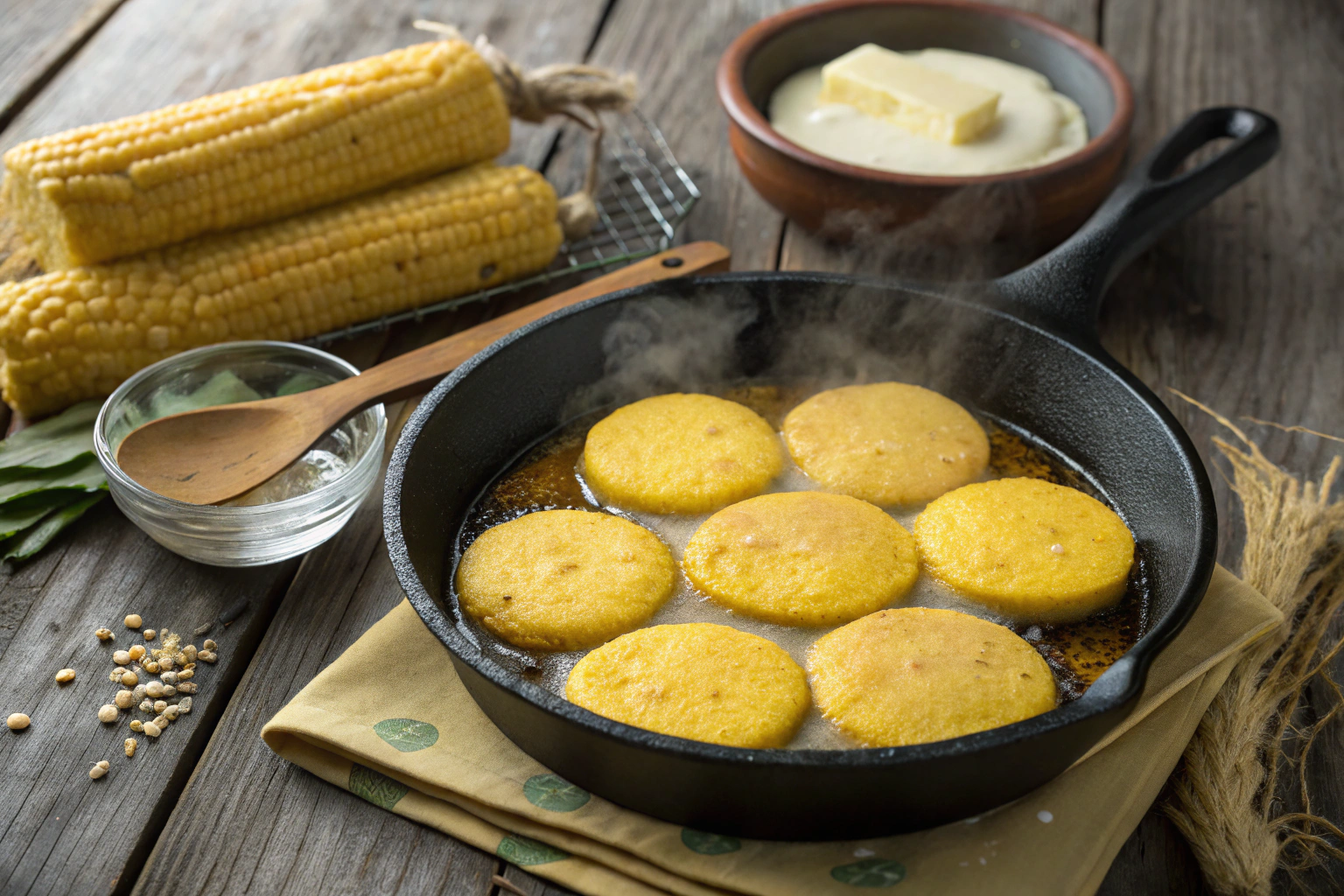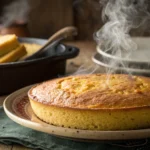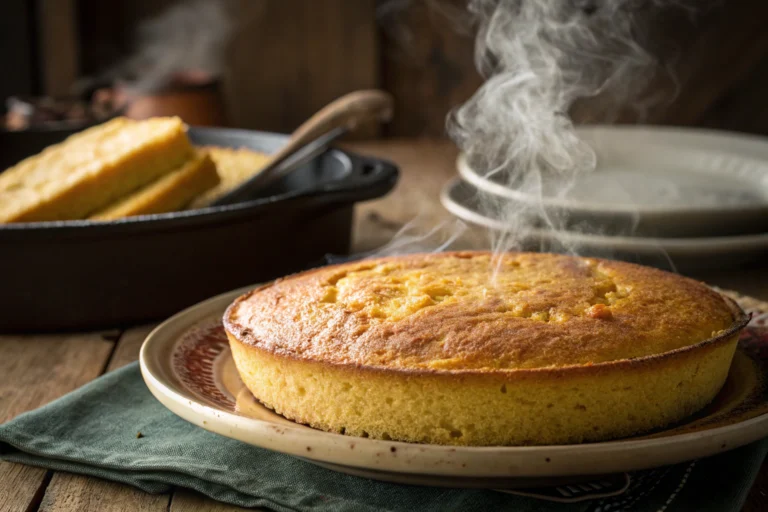The golden-brown edges crackling as the patties hit the hot oil, that distinctive corn aroma wafting through my grandmother’s kitchen on Sunday afternoons—these memories of hot water cornbread are etched into my Southern upbringing like family heirlooms. This humble yet remarkable bread, with its crispy exterior and soft, steamy interior, has been a staple at Southern tables for generations.
Did you know that cornmeal-based recipes date back over 7,000 years in indigenous North American cooking traditions? This remarkable staying power speaks to both the simplicity and versatility of hot water cornbread, a dish that requires minimal ingredients yet delivers maximum flavor.
Why Hot Water Cornbread Matters
Hot water cornbread stands apart from other cornbread variations because of its unique preparation method. Unlike baked cornbread, which uses cold ingredients and leavening agents, hot water cornbread relies on scalding water to partially cook the cornmeal before frying, creating that distinctive crispy-outside, tender-inside texture that has made it a beloved Southern classic.
For those interested in exploring different approaches to this traditional recipe, both Divas Can Cook and Grandbaby Cakes offer excellent traditional variations. If you’re planning a full Southern meal, consider pairing your cornbread with Street Corn Chicken Casserole or serving it alongside Cheesy Garlic Butter Flatbread for a fusion-inspired spread.
Ingredients for Perfect Hot Water Cornbread
Hot Water Cornbread Ingredients
- 2 cups yellow cornmeal (stone-ground preferred)
- 1 teaspoon salt
- 1 tablespoon sugar (optional, for a touch of sweetness)
- 2 cups boiling water
- 2-3 tablespoons vegetable oil (for frying)
- ¼ cup all-purpose flour (optional, for binding)
- ½ teaspoon baking powder (optional, for a lighter texture)
The simplicity of hot water cornbread is perhaps its most beautiful quality. With just cornmeal, water, and salt, you can create little golden discs of comfort that transport you straight to a Southern grandmother’s kitchen. When the hot water hits the cornmeal, it releases an earthy, sweet aroma that promises the satisfaction to come.
Ingredient Spotlight
Cornmeal: The star of hot water cornbread, cornmeal provides not just structure but flavor. Stone-ground yellow cornmeal offers more texture and corn flavor than finely ground varieties. The coarser grind creates tiny air pockets during cooking, contributing to the bread’s perfect texture.
Hot Water: The scalding water partially cooks the starches in the cornmeal, creating the distinctive gelatinized texture that allows the patties to hold together without eggs. This is the transformative element that makes hot water cornbread different from other cornbread varieties.
Salt: More than just seasoning, salt highlights the natural sweetness of corn and balances the flavors. Without it, your cornbread would taste flat and one-dimensional.
Sugar: While purists might skip it, a touch of sugar enhances the natural sweetness of the corn and helps achieve that beautiful golden-brown exterior during frying.
Timing
- Preparation time: 10 minutes
- Cooking time: 15 minutes
- Total time: 25 minutes
One of the joys of hot water cornbread is its efficiency—it comes together nearly 40% faster than traditional oven-baked cornbread. This quick-cooking bread was historically perfect for busy farm families who needed satisfying food without spending hours in a hot kitchen.
Instructions
Step 1: Prepare Your Dry Ingredients
Whisk together the cornmeal, salt, sugar (if using), and any optional additions like flour or baking powder in a heat-resistant bowl. Creating this uniform mixture ensures even hydration when the hot water is added. My grandmother always used a wooden spoon for mixing, claiming metal would affect the flavor—a superstition I still honor.
Step 2: Add Boiling Water
Carefully pour the boiling water over your dry ingredients, stirring constantly to prevent lumps. The transformation is immediate and magical—the cornmeal mixture will thicken and change color slightly as the hot water partially cooks the cornmeal. Keep stirring until no dry pockets remain and the mixture is thick enough to hold its shape when scooped.
Step 3: Let Rest
Allow the mixture to cool for about 5 minutes until it’s comfortable to handle. This resting period also lets the cornmeal fully hydrate, creating a more cohesive dough. I use this time to prepare my frying station and any accompaniments like honey butter or collard greens.
Step 4: Shape the Patties
With slightly damp hands (to prevent sticking), scoop about 3 tablespoons of the mixture and shape into a patty about ½-inch thick. Traditional hot water cornbread patties are oval or round, but I’ve seen creative cooks make everything from triangles to small droplets. The important thing is consistency in thickness for even cooking.
Step 5: Fry to Golden Perfection
Heat vegetable oil in a heavy skillet (cast iron is ideal) over medium heat until shimmering but not smoking. Carefully add your cornbread patties, being careful not to overcrowd the pan. Fry for 3-4 minutes per side until deeply golden and crispy. You’ll know they’re ready to flip when the edges become visibly dry and firm.
Step 6: Drain and Serve
Remove the fried hot water cornbread patties to a paper towel-lined plate to absorb excess oil. Serve immediately while still hot for the ultimate experience—crispy exterior giving way to a steamy, tender interior.
Tips & Tricks for Perfect Hot Water Cornbread
Temperature Matters: Keep your water at a rolling boil before adding it to the cornmeal. Water that’s merely hot won’t properly gelatinize the cornmeal starches.
Oil Check: Test your oil temperature by dropping a small pinch of the cornmeal mixture into the pan—it should sizzle immediately but not smoke or burn.
Even Thickness: Maintain consistent thickness in your patties for even cooking. Too thick, and they’ll be doughy inside; too thin, and they’ll become too crisp and lose their tender center.
Don’t Overcrowd: Fry in batches if necessary. Crowding the pan lowers the oil temperature and results in soggy rather than crispy cornbread.
Hands-On Test: When the mixture has cooled enough that you can comfortably form patties without burning your hands, it’s ready to shape. If it’s too loose, let it cool a bit more to thicken.
Recipe Variations & Substitutions
Sweet Hot Water Cornbread
Increase sugar to 3 tablespoons and add 1 teaspoon of vanilla extract. Some Southern families serve this version with honey or sorghum syrup for breakfast.
Herb-Infused Cornbread
Add 2 tablespoons of finely chopped fresh herbs like chives, rosemary, or thyme to the dry ingredients. This savory variation pairs beautifully with soups and stews.
Gluten-Free Hot Water Cornbread
Good news! Traditional hot water cornbread is naturally gluten-free if you skip the optional flour. Just ensure your cornmeal is processed in a gluten-free facility if you have celiac disease or severe sensitivity.
Dairy-Enhanced Version
Add ¼ cup of grated sharp cheddar and 2 tablespoons of buttermilk to the mixture for a richer, more complex flavor profile.
Behind the Recipe
Hot water cornbread emerged from necessity in Southern kitchens where resources were limited but ingenuity abounded. Before the widespread availability of ovens, cooking was done primarily on stovetops or open fires, making fried breads practical everyday options. African American culinary traditions significantly influenced the development of this recipe, combining African techniques with indigenous American ingredients.
My own family recipe came through my grandmother, who learned it from her mother in rural Georgia. On Sundays after church, she’d fry up batches of hot water cornbread to accompany whatever vegetables had been harvested from the garden that week. The recipe hasn’t changed in three generations—a testament to perfection in simplicity.
Pairing Ideas
Hot water cornbread is exceptionally versatile as a companion to many dishes:
- Serve alongside slow-cooked collard greens, the cornbread perfect for sopping up the flavorful pot liquor
- Pair with black-eyed peas and tomato relish for a traditional Southern plate
- Complement spicy chili with these cornbread patties instead of crackers
- Serve with honey butter and fresh berries for a surprising breakfast option
- Use as a base for Southern eggs Benedict, substituting for English muffins
Leftover & Reuse Ideas
While hot water cornbread is best fresh from the skillet, leftovers can still shine:
- Crumble into a bowl of buttermilk for a traditional Southern snack called “crumble-in”
- Use as the foundation for breakfast—top with a fried egg and avocado
- Slice horizontally and toast, then use as the base for open-faced sandwiches
- Crumble and add to stuffing mixtures for added texture and corn flavor
- Pulse in a food processor to create cornbread crumbs for coating chicken or fish
Nutritional Information
A single patty of traditional hot water cornbread contains approximately:
- Calories: 120-150 per patty
- Carbohydrates: 22g
- Protein: 2g
- Fat: 5g
- Fiber: 2g
- Sodium: 240mg (varies based on salt added)
Serving Suggestions
Present your hot water cornbread with flourish by:
- Arranging patties in a spoke pattern on a round platter with a small bowl of honey butter in the center
- Serving individual patties in small cast iron servers for a rustic presentation
- Creating a hot water cornbread basket lined with a colorful cloth napkin
- Setting up a toppings bar with butter, honey, preserves, and savory options like pepper jelly
- Using as a unique base for appetizers—top with pulled chicken and coleslaw for mini Southern sliders
Common Mistakes to Avoid
Too Much Water: Adding excessive water makes the mixture too loose to form patties. The consistency should be similar to thick mashed potatoes.
Oil Temperature Issues: Oil that’s too hot will burn the outside while leaving the inside doughy; oil that’s too cool will make greasy, soggy cornbread.
Premature Flipping: Moving the patties too soon disrupts their structure. Wait until the edges look dry and set before attempting to turn them.
Inadequate Seasoning: Cornmeal needs proper seasoning. Taste your mixture before frying—it should be distinctly savory (or sweet, depending on your preference).
Inconsistent Size: Varying sizes mean inconsistent cooking times. Use a measuring scoop for uniformity if you’re new to making hot water cornbread.
Storage & Reheating Tips
Hot water cornbread is ideally consumed fresh, but if you must store leftovers:
- Cool completely before placing in an airtight container
- Refrigerate for up to 3 days
- Reheat in a 350°F oven for 5-7 minutes to restore some crispness
- Alternatively, reheat in a dry skillet over medium heat for 1-2 minutes per side
- Freezing is not recommended as it significantly alters the texture
FAQs About Hot Water Cornbread
Is hot water cornbread gluten-free?
Traditional hot water cornbread made with just cornmeal, water, and salt is naturally gluten-free. However, some recipe variations add wheat flour for binding, so check ingredients carefully if you have gluten sensitivity.
Why is my hot water cornbread falling apart when frying?
If your hot water cornbread is crumbling during frying, your mixture may be too dry or the water wasn’t hot enough to properly gelatinize the cornmeal starches. Make sure to use boiling water and let the mixture cool slightly before shaping.
Can hot water cornbread be baked instead of fried?
While traditionally fried, hot water cornbread can be adapted for baking. Form patties on a well-greased baking sheet and bake at 425°F for about 15 minutes, turning halfway through. The texture will be different—less crispy on the outside and drier overall—but still delicious.
How can I make my hot water cornbread more moist?
For moister hot water cornbread, you can add 2-3 tablespoons of creamed corn to the mixture or incorporate ¼ cup of grated sweet onion, which releases moisture during cooking.
What makes hot water cornbread different from regular cornbread?
The key difference is in preparation and texture. Hot water cornbread uses boiling water to partially cook the cornmeal before frying, creating individual patties with a crispy exterior and tender interior. Regular cornbread typically uses cold ingredients with leavening agents and is baked in a pan or skillet.
Conclusion
Hot water cornbread represents Southern cooking at its most fundamental—simple ingredients transformed through technique into something greater than the sum of its parts. This humble bread carries centuries of culinary wisdom and cultural heritage in each crispy, tender bite.
What makes this recipe endure isn’t just its practicality or affordability, but its ability to transport us back to family tables across generations. In a world of complicated cooking trends, there’s something profoundly satisfying about mastering this elemental recipe.
Made these hot water cornbread patties? Drop your twist in the comments, rate the recipe, and tag us on facebook, instagram with #erinrecipes — we might feature your creation!
Print
How to Make Southern Hot Water Cornbread (Easy Recipe)
- Total Time: 25 minutes
- Yield: 8 patties 1x
Description
Crispy on the outside, steamy and tender on the inside, this Southern Hot Water Cornbread is a classic fried bread that celebrates simplicity, tradition, and unforgettable flavor.
Ingredients
- 2 cups yellow cornmeal (stone-ground preferred)
- 1 teaspoon salt
- 1 tablespoon sugar (optional)
- 2 cups boiling water
- 2–3 tablespoons vegetable oil (for frying)
- ¼ cup all-purpose flour (optional)
- ½ teaspoon baking powder (optional)
Instructions
- In a heatproof bowl, whisk together cornmeal, salt, sugar (if using), and optional flour or baking powder.
- Carefully pour boiling water over the dry ingredients, stirring constantly until the mixture thickens and no dry spots remain.
- Let the mixture rest for 5 minutes to fully hydrate and cool slightly.
- With damp hands, shape about 3 tablespoons of the mixture into ½-inch thick patties.
- Heat vegetable oil in a skillet over medium heat. Fry patties 3–4 minutes per side until golden and crispy. Do not overcrowd the pan.
- Transfer to a paper towel-lined plate to drain. Serve hot and fresh for best texture and flavor.
Notes
Use boiling water to activate the cornmeal’s starches for structure. Stone-ground cornmeal gives the best texture, and a hot skillet ensures a crispy crust.
- Prep Time: 10 minutes
- Cook Time: 15 minutes
- Category: Side Dish
- Method: Fried
- Cuisine: Southern
Nutrition
- Serving Size: 1 patty
- Calories: 140
- Sugar: 1g
- Sodium: 240mg
- Fat: 5g
- Saturated Fat: 1g
- Unsaturated Fat: 4g
- Trans Fat: 0g
- Carbohydrates: 22g
- Fiber: 2g
- Protein: 2g
- Cholesterol: 0mg
Keywords: hot water cornbread, fried cornbread, southern side, easy cornbread recipe
Fresh recipes are waiting in your inbox.

